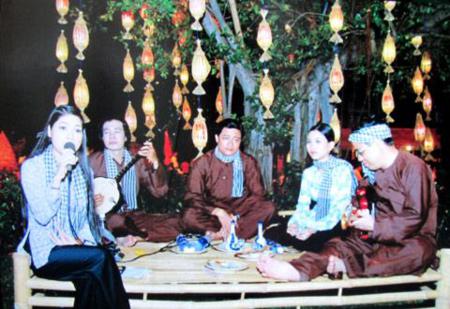Don ca tai tu is younger than other kinds of Vietnamese traditional music like Xoan singing, Ceremonial singing, Xam singing, and Chau Van singing, but it’s grouped with Vietnamese traditional music for a number of reasons. One of the most important reasons is that today, although Vietnamese culture is threatened by cultural integration, information technology and globalization, the people of Southern Vietnam appreciate and maintain this art form in their daily life. In this edition of the Sunday show, we’ll look at this folk songs and why Vietnam wants to win UNESCO regconition for it.
“Don ca tai tu” – traditional improvisational chamber music – emerged in the south at the end of the 19th century. It is now performed mainly in two places, taverns and tourist sites. Ut Ty, a veteran performer in Ho Chi Minh City said: “According to our ancestors, in the past, the music was performed to entertain high-ranking officials when they held parties. As time passed, Tai tu performers began to participate in exchanges instead of just having fun at parties. Tai tu performers can perform in a group or solo. In the past, performers is usually sat and performed solo but nowadays, they usually form a band and stand up for performances, which have evolved into Cai luong or reformed theatre”.
A traditional Tai tu orchestra includes a Vietnamese two-string guitar, a Vietnamese 16-string zither, a Chinese four-string lute, a Vietnamese two-string fiddle, a monochord and a flute. Since the middle of the 20th century, guitar and violin – two Western musical instruments – have been added to the orchestra. In order to make these new musical instruments compatible with the others, the guitars frets have been made deeper, and both instruments have been retuned. All Tai tu musicians have to learn by heart the basic tunes of their repertoire from which they can improvise, while still maintaining the music’s integrity, according to Ut Ty. “Although now there are hundreds of pieces in the Tai Tu repertoire, anyone who wants to master the music must learn by heart 20 original tunes enumerated by professor Nguyễn Quang Đại, known as Ba Đợi from Long An province. These 20 tunes include six tunes from the north, 7 pieces from central VN, 3 pieces of the south and four Oán tunes”.
This kind of music is performed not only at parties, but also in the post-harvest time. It is played in the shade of trees or on boats, on a bright moonlit night. This southern amateur music cannot be found on modern stages or in cultural or tourism festivals. This genre of chamber music is usually performed on ‘plank beds’ in living rooms in southern traditional houses.
But, Tai tu could fall into oblivion unless an effort is made to preserve this precious cultural heritage. The Ministry of Culture, Sports and Tourism has asked the Institute for VNese Music and departments of Culture, Sports and Tourism in the South to build up a file for submission to UNESCO, to get Tai tu recognized as an intangible Vietnamese cultural heritage. Nguyễn Văn Tấn, Director of the representative office of the Ministry of Culture, Sports and Tourism in Ho Chi Minh City said: “Vietnamese history has created many precious heritages. One of them is this southern improvisational chamber music. The music originated from devotional music, Hue royal court music and folk literature. More importantly, the music reflects the creative and chivalrous character of southern people. It has created an immortal vitality despite the severe challenges of the time”.
Some elders say that many of the don ca tai tu troupes do not care to separate cai luong and don ca tai tu when performing and audiences are indifferent as well. In addition, even some descendants of famous don ca tai tu artists are no longer interested in the art. Le Dinh Bich, a don ca tai tu lecturer at Can Tho University, bemoans the fact that for every 100 students in his class, there is only one that truly respects the art, whereas many foreigners really appreciate it. They even study and research it for their PhDs. The compilation of a dossier for UNESCO recognition is a way to preserve Vietnam’s cultural heritage and raise the community’s awareness of the art while promoting Vietnam’s image to attract more tourists. Mr Tan said: “The work began last July and it requires a close cooperation among relevant agencies and a great determination. There remains a lot of work to be done, requiring not only dedication but qualification of those involved. By the end of August at the latest, we have to finalize the documents for UNESCO”.
Source: Vovworld.vn

